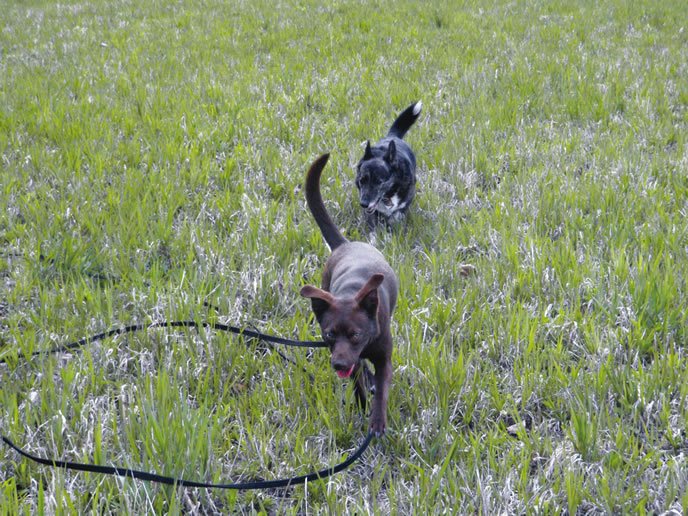
Adding a new dog to the family is always a significant event. I recently realized that there is a finite number of new dogs in my and my husband’s future, and it made adopting our latest new one take on even more significance. Plus, as a trainer, I’m under a certain amount of added pressure to “do it right.” People might be watching, and what if I mess it up? So, as we prepared to add an Australian Kelpie from a rescue group to our family, I reviewed the advice I’ve given to other new dog owners over the years, and made sure we applied it to our own situation.
First impressions
For starters, as I recommended in “How to Prevent a Bad Adoption” (WDJ May 2015), my husband Paul and I planned to wait until we found the right dog for us, and to meet the dog to confirm this choice before committing to the adoption. Paul and I had agreed that if, when we drove five hours to go meet the dog, we did not find him to be as represented by his rescuers (friendly, happy, outgoing), we would come home without him.
We also knew that we would have to temper our own excitement when meeting him so we didn’t overwhelm him with silly primate behaviors like direct eye contact, patting, and hugging.
We needn’t have worried on either count. He was just as wildly enthusiastic about greeting us as we were about meeting him. He looked confidently into our eyes, and welcomed any attention we offered.
Reading Canine Body Language
After our mutually enthusiastic greeting, we took a step back to observe Kai a little more carefully. Everything we saw confirmed what we had hoped. He stood tall and forward, taking everything in stride with a happy, swishing tail. He sought human interaction, both from us and the two rescue workers he was already familiar with, playing no favorites. He eagerly gobbled the treats we offered (dogs who are highly food motivated are easier to train than dogs who are not as interested in food), and lured to a down easily. He caught tossed treats in mid-air and easily leaped onto a raised surface when invited. He did not appear in the least concerned about the numerous other rescue dogs outside the windows on both sides of the room we were in. Confident and well socialized, slender, agile, and healthy – check!
Suggested Resource:
The Language of Dogs
by Sarah Kalnajs
(2006 DVD)
Proper Identification
It’s never too soon to equip your new dog with multiple forms of identification. Kai came with an ID tag from his rescue, but we filled out a Jiffy Tag we had brought with us and attached it before we even loaded him into the car. Jiffy Tags are handy, instant pet ID tags that you seal in plastic. You just write your information on the two-sided paper tag, then seal it between two pieces of clear, hard, adhesive plastic, and then use a regular metal ring to attach it to the dog’s collar.
Kai was already microchipped by the rescue, but we registered the microchip in our name online when we got home. We also added a current rabies tag and county dog license in short order.
Suggested Resource:
Jiffy Tags
from Animal Care Equipment & Services
(800) 338-2237; animal-care.com
Introductions
If you’re an animal lover like me, chances are your new dog isn’t your only animal companion. Proper introductions to the rest of your family members can go a long way toward a harmonious future. We may have more animal family members than most people; we have three other dogs, seven cats, six chickens, a pot-bellied pig, six horses of our own, and seven horses boarded.
When we were meeting Kai for the first time, we asked if the rescue staff could bring a cat into the get-acquainted room, to make sure our prospective family member wasn’t a dedicated cat hater. That introduction went well, so we figured we were on solid ground with the cats.
We had seen that Kai was good with other dogs at the rescue. It’s ideal to introduce a new dog to your current canine family in a neutral fenced area; absent this, we made do with our indoor riding arena. We started with Lucy, our 11-year-old Cardigan Corgi, who is the queen of the farm. Lucy can be inappropriately pushy and assertive, so we figured we’d get the hardest introduction over with first.
As is my custom, we first allowed the dogs to see each other, on leashes, from opposite sides of the arena. Then we approached to a distance of about 10 feet, and, when the dogs’ body language looked reasonable (interested, happy, alert, excited), we dropped the leashes and let the two dogs meet. All went well. Despite his confident personality, Kai immediately deferred to the Queen, and has continued to do so ever since, even when she rudely grabbed his chewie.
Even though he’s deferent when Lucy is being bossy, he’s also playful and irreverent. In fact, last week he grew so bold as to dash past her at top speed and grab a stick from her mouth! He was so fast, that by the time she realized it and launched after him he was far out of her reach. No dog has ever done that before and escaped unscathed.
It was a breeze to introduce Kai to 10-year-old Bonnie, a Scotti/Corgi/Poodle-mix; she pretty much loves everyone. She plays well with Kai, and even tolerates him nicely when his level of play is a little more energetic than she might like. She occasionally tells him to back off, and he does so.
In the past, our 13-year-old Pomeranian, Scooter, has suffered from hemorrhagic gastroenteritis when introduced to high-energy dogs. We were a little concerned, but we needn’t have been. Kai was very respectful of Scooter, and got the message immediately that Scooter was not going to play with him, so now he doesn’t even try.
Our cats are already pretty dog-savvy, albeit a little cautious due to Lucy’s proclivity to engage in cat herding from time to time. From the demonstration at the rescue, we expected Kai to do well with our cats, and we weren’t disappointed. We simply brought him into the house and let him meet the three house cats as they chose to make their appearance. (We have parts of the house baby-gated so the cats can come and go freely, with the dogs restricted to only certain rooms).
Kai showed a friendly interest in the cats, but no inclination to chase them, and they are already more comfortable with him than they are with Lucy. If we did not have prior information about Kai’s response to cats, we would have made the introductions with Kai on a leash so we could observe his behavior before giving him free access to the cats.
Dorothy the barn cat chose to greet Kai with head bumps (something she never does to Lucy). Kai hasn’t met the three feral cats that live in the lower barn, and we’re in no hurry to have that happen.
Our chickens live in fenced enclosures, so we don’t worry about the dogs (or visiting dogs) grabbing them. Kai shows some interest through the fence at the fluttering creatures, but he’s not intense about it. I’m doing a little counter-conditioning (chickens make chicken happen?) to keep his interest at a healthy level.
Kai is quite taken with Sturgis, our pot-bellied pig. Sturgis, on the other hand, has very little interest in playing with dogs, including Kai. He has quite effectively taught the other three to leave him alone with a couple of well-timed pig lunges, but Kai seems to think Sturgis wants to play when the annoyed pig charges at him. Fortunately, it’s easy to call Kai away from Sturgis, and I am consistently reinforcing incompatible behaviors (sitting for treats and “find it” are behaviors that are incompatible with playing with Sturgis).
So far, the horses have posed the biggest self-control challenge to our new little stock dog. Kai is having difficulty controlling his enthusiasm around the horses, and I am concerned that one might kick and injure him. For a while I was reinforcing an incompatible behavior while leading a horse (this worked well with our now-deceased Scottish Terrier, Dubhy), but Kai couldn’t resist barking and leaping at the large animals. For now, I am managing the situation by putting Kai in a stall when we move horses around during morning barn chores. I will be setting aside some time for more concentrated work on this in the near future.
Suggested Resource:
“Great Introductions”
WDJ, January 2008



Welcome Home
Almost every new four-legged addition to the Miller family has, in the past, triggered at least one “What have I done?” moment. To his credit, Kai has not. I did, however, experience a reality check upon bringing him into the house for the first time, having just seen him leap straight into the air onto an eight-foot pile of hay bales in the barn. We had three-foot baby gates already in place that would clearly be no match for him if he wanted to sail over them, and our four-foot kitchen counter suddenly looked pitifully low and vulnerable.
We also had no idea if he was housetrained, having just fetched him from a rescue house that contained at least a dozen dogs and smelled strongly of urine. I knew there would be no house freedom for this Kelpie for at least a few days, until we got to know him better.
The leash stayed attached to Kai’s collar at one end, and to me at the other end, for the first two days, except when he was in the barn, the backyard, or crated (the umbilical cord method). Fortunately he was happy to tag along after me, or curl up on a blanket at my feet beneath my desk, and Lucy, who generally considers my office to be exclusively hers, was willing to share. Also fortunately, over those two days, Kai showed no inclination to lift his leg in the house.
At the end of two days I began dropping the leash, still keeping a close eye on our new boy. The drag line would enable me to corral him quickly if necessary. It wasn’t necessary. After a day with the drag line, I took the leash off, and Kai joined the family, a full-fledged free dog. Almost.
Because of his love affair with raised surfaces, we keep the door to the laundry room closed. We have a small freezer in that room, the top of which is cluttered with containers of dog treats, some of them open – no doubt too much of a temptation for our levitating lad. We don’t leave food unattended on kitchen counters, so there’s no temptation there, and we haven’t even seen him try to make that leap. He hasn’t tested the meager three-foot baby gates, thank goodness. However, we did discover that he likes to raid trash cans. Our kitchen receptacle is already covered, as is the one in my office, but we are keeping the living room off limits to Kai unless we are with him, until we get another covered can for that room. It’s already ordered.
Kai quickly fit into the rest of the Miller household routine. He was easily enticed into a crate for a few bits of cheese the first few days, and was soon running into his crate on cue. (He is crated at night and when we are not home.) He didn’t know the “Wait” cue, but with a just few repetitions on the first day he was waiting with Bonnie and Lucy on the stairway landing until I reached the bottom of the stairs and invited them to follow – our standard precaution to prevent the dogs from accidentally tripping us on the stairs. He very quickly generalized the “Wait” cue to doors (barn and house), his food bowl, and other useful opportunities.
He was pleased to discover that dogs are allowed on furniture in the Miller home. From the first day he waited politely for my invitation to jump up and snuggle next to me on the sofa (on my left side – Bonnie gets my right side). I love dog snuggling, so he gets invited a lot.
Suggested Resource:
Do-Over Dogs
by Pat Miller
(2010, Dogwise Publishing)
The Great Outdoors
The biggest challenge about the great outdoors is convincing your dog that he wants to come back to you when you ask him to. There are so many good things to sniff and chase! A solid recall gives you and your dog much more freedom and many more options when you venture out. I started practicing recalls with Kai his first day home.
Confession: I did fail to follow my own excellent advice about fences. I knew that our four-foot fence wouldn’t contain Kai if he decided to go over, but didn’t even think about the fact that most of the fence was in pretty poor repair.
During his first week with us, probably about the fifth day, I had stashed Bonnie and Kai in the yard after morning farm chores while I went to the lower barn to feed our chickens. Suddenly I heard a ka-thump sound, and a brown streak was racing across the yard. Kai was loose! I had several days of practicing recalls with him in the barn, but he was loose! Fortunately, he did one lap around the yard and then came directly to me. Of course I showered him with the treats that I always carry in my pockets.
I prayed he had found a loose board, and not jumped the fence. It would be much easier to fix the fence than raise it. Fortunately that proved to be the case. Paul fixed the fence that day, and Kai hasn’t escaped since.
I have, however, taken him on many hikes around the farm, to one field in particular that is surrounded on three sides by a healthy creek. I discovered that Kai doesn’t like to get his feet wet, so this field is effectively fenced on three sides for Kai. I started with Kai on a long line, doing lots of recalls, then worked up to dropping the long line while we hiked around this field, still keeping him close to me by calling him back frequently, and rewarding with high-value treats. Eventually I was comfortable allowing him free run of this field, off-leash. He is proving to have a pretty reliable recall, and we are about to take the next step: off leash in slightly less-protected areas of the farm. I am confident that in short order we will be comfortable having Kai accompany us off leash anywhere on the farm.
Suggested Resource:
“Rocket Recalls”
WDJ, September 2012
Really Reliable Recall
by Leslie Nelson
(2004 DVD or Booklet, Healthy Dog Productions)
Training
Of course I would enroll Kai in a training class . . . but where? We had a new seven-week Basic Good Manners Class starting here at Peaceable Paws with trainer Jill Friefeld, CPDT-KA, just a week after Kai came home, so I signed him up. We graduated last week, and earned honors for the “Fastest Recall.” A past Peaceable Paws trainer, Laura Nalven, CPDT-KA, PMCT, has just opened up her own training business in nearby Hagerstown, and we’re signed up for her first class starting June 3rd, at Atta Pup! Dog and Puppy Training. We’re also attending her Canine Games Night once a month, for added fun and social exposure. It’s far too easy for a farm dog, even one at Peaceable Paws, to lose sight of all the stimulation and entertainment the rest of the world has to offer.
After that, who knows? He has passed his first days with flying colors. Maybe we should do Herding. Or Rally. Or Freestyle. Or Agility. Maybe we’ll delve deeper into Imitation Training. It’s still early days (exactly two months since the little red Kelpie joined our family), and with a dog as brilliant and solid as Kai, the sky’s the limit. We’ll keep you posted. But even more important… even if he never does anything more than live on the farm, we are totally, completely and utterly smitten with our new boy. Which is how it should be.
Suggested Resource:
The Power of Positive Training
by Pat Miller
(2008, DogWise Publishing)
Pat Miller is WDJ’s Training Editor.





